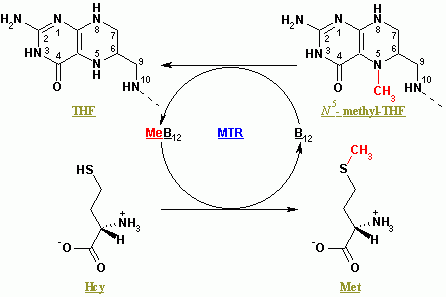Methionin-Synthase
aus Wikipedia, der freien Enzyklopädie
| N5-Methyl-Tetrahydrofolat-Homocystein-S-Methyltransferase | ||
|---|---|---|

| ||
| Eigenschaften des menschlichen Proteins | ||
| Masse/Länge Primärstruktur | 1227 Aminosäuren | |
| Bezeichner | ||
| Gen-Name | MTR | |
| Externe IDs | ||
| Enzymklassifikation | ||
| EC, Kategorie | 2.1.1.13, Transferase | |
| Substrat | 5-Methyltetrahydrofolat, L-Homocystein | |
| Produkte | Tetrahydrofolsäure, L-Methionin | |
| Vorkommen | ||
| Homologie-Familie | HOG000251409 | |
| Übergeordnetes Taxon | Lebewesen | |
Die Methionin-Synthase (Gen: MTR, auch als Homocystein-Methyltransferase bekannt) katalysiert den letzten Schritt in der Regeneration von Methionin (Met) aus Homocystein (Hcy) mithilfe des Cofaktors Methylcobalamin bzw. Vitamin B12.
Methionin ist eine essentielle Aminosäure, die vom menschlichen Körper nicht de novo synthetisiert wird. Sie ist Ausgangssubstanz für S-Adenosylmethionin, welches eine wichtige Quelle für aktive Methylgruppen darstellt.[1]
Eine Fehlfunktion der Methionin-Synthase scheint auch Ursache für Neuralrohrdefekte zu sein.[2]
Funktion
Literatur
- Y. N. Li, S. Gulati, P. J. Baker, L. C. Brody, R. Banerjee, W. D. Kruger: Cloning, mapping and RNA analysis of the human methionine synthase gene. In: Hum Mol Genet. 5 (12), Dezember 1996, 1851–1858. doi:10.1093/hmg/5.12.1851. PMID 8968735.
- R. V. Banerjee, R. G. Matthews: Cobalamin-dependent methionine synthase. In: FASEB J. 4 (5), März 1990, S. 1450–1459. PMID 2407589.
- T. M. Zydowsky: Stereochemical analysis of the methyl transfer catalyzed by cobalamin-dependent methionine synthase from Escherichia coli B. In: Journal of the American Chemical Society. 108 (11), 1986, S. 3152–3153. doi:10.1021/ja00271a081.
- Z. Zhang, C. Tian, S. Zhou, W. Wang, Y. Guo, J. Xia, Z. Liu, B. Wang, X. Wang, B. T. Golding, R. J. Griff, Y. Du, J. Liu: Mechanism-based design, synthesis and biological studies of N5-substituted tetrahydrofolate analogs as inhibitors of cobalamin-dependent methionine synthase and potential anticancer agents. In: European Journal of Medicinal Chemistry. 58, 2012, S. 228–236. doi:10.1016/j.ejmech.2012.09.027. PMID 23124219.
- R. G. Matthews, A. E. Smith, Z. S. Zhou, R. E. Taurog, V. Bandarian, J. C. Evans, M. Ludwig: Cobalamin-Dependent and Cobalamin-Independent Methionine Synthases: Are There Two Solutions to the Same Chemical Problem? In: Helvetica Chimica Acta. 86 (12), 2003, S. 3939. doi:10.1002/hlca.200390329.
- K. R. Wolthers, N. S. Scrutton: Protein Interactions in the Human Methionine Synthase-Methionine Synthase Reductase Complex and Implications for the Mechanism of Enzyme Reactivation. In: Biochemistry. 46 (23), 2007, S. 6696–6709. doi:10.1021/bi700339v. PMID 17477549.
- R. Pejchal, M. L. Ludwig: Cobalamin-Independent Methionine Synthase (MetE): A Face-to-Face Double Barrel That Evolved by Gene Duplication. In: PLoS Biology. 3 (2), 2005, S. e31. doi:10.1371/journal.pbio.0030031. PMC 539065 (freier Volltext). PMID 15630480.
- J. C. Evans, D. P. Huddler, M. T. Hilgers, G. Romanchuk, R. G. Matthews, M. L. Ludwig: Inaugural Article: Structures of the N-terminal modules imply large domain motions during catalysis by methionine synthase. In: Proceedings of the National Academy of Sciences 101 (11), 2004, S. 3729–3736. doi:10.1073/pnas.0308082100. PMC 374312 (freier Volltext). PMID 14752199.
- H. Hesse, R. Hoefgen: Molecular aspects of methionine biosynthesis. In: Trends in Plant Science. 8 (6), 2003, S. 259–262. doi:10.1016/S1360-1385(03)00107-9. PMID 12818659.
- O. Outteryck, J. De Sèze, T. Stojkovic, J. -M. Cuisset, D. Dobbelaere, S. Delalande, A. Lacour, M. Cabaret, A.-C. Lepoutre, V. Deramecourt, H. Zéphir, B. Fowler, P. Vermersch: Methionine synthase deficiency: A rare cause of adult-onset leukoencephalopathy. In: Neurology. 79 (4), 2012, S. 386–388. doi:10.1212/WNL.0b013e318260451b. PMID 22786600.
Einzelnachweise
- ↑ Holger Hesse, Rainer Hoefgen: Molecular aspects of methionine biosynthesis. In: Trends in Plant Science. Band 8, Nr. 6, Juni 2003, S. 259, doi:10.1016/S1360-1385(03)00107-9 (englisch).
- ↑ Eintrag zu Neuralrohr-Defekte. In: Römpp Online. Georg Thieme Verlag, abgerufen am 3. März 2015.
